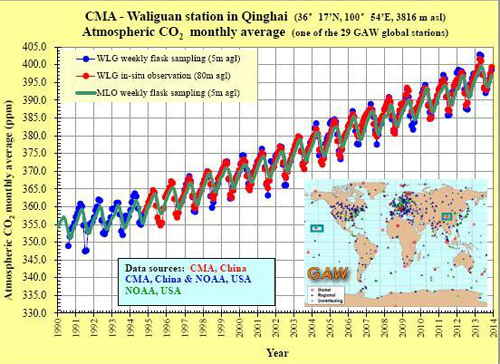

BEIJING, Jan. 12-- On 9 January, 2014, China Meteorological Administration (CMA) published the China Greenhouse Gas Bulletin, which based on Chinese and Global observations of greenhouse gases in the atmosphere through 2013.
Since 1980s, CMA has put in place seven atmospheric background stations--Waliguan in Qinghai (WLG), Shangdianzi in Beijing (SDZ), Lin'an in Zhejiang (LAN), Longfengshan in Heilongjiang (LFS), Shangri-La in Yunnan (XGL), Jinsha in Hubei (JSA) and Akedala in Xinjiang (AKD), which represent a number of typical climatic, ecological and economic zones in China.
Greenhouse gases and related tracers have been observed by network stations in a standard and consistent routine in response to the Kyoto Protocol and the Montreal Protocols. The upper left figure shows the monthly CO2 mole fractions observed at the Waliguan station in Qinghai province, China and the Mauna Loa station in Hawaii, the United States of America. The upper right figure displays the atmospheric radiative forcing, relative to 1990, of LLGHGS at the Waliguan station (the CO2-equivalent amounts# reached to 483 ppm in 2013) and the Annual Greenhouse Gas Index (AGGI)## based on the approach used by the WMO greenhouse gas bulletin.

EXECTIVE SUMMARY
The World Meteorological Organization (WMO) Greenhouse Gas Bulletin (2013) No. 10 released by WMO on 6 November 2014 shows that globally averaged mole fractions in atmospheric carbon dioxide (CO2), methane (CH4) and nitrous oxide (N2O) continued to hit new highs in 2013, with CO2at 396.0± 0.1 ppm, CH4at 1824± 2 ppb and N2O at 325.9 ± 0.1 ppb. These values constitute 142%, 253% and 121% of pre-industrial (before 1750) levels.
As analyzed from observational data at the Waliguan station in Qinghai through 2013, averaged mole fractions in atmospheric CO2, CH4 and N2Oalso hit new highs, registering 397.3±0.8 ppm for CO2, 1886±3 ppb for CH4and 326.4±0.4 ppbfor N2O. As a record high since the observation was started in 1990, they are roughly equivalent to the averaged mole fractions in the northern mid-latitudes, but are slightly higher than the global averages in all these components (396.0±0.1 ppm, 1824±2 ppb and 325.9±0.1 ppb) over the same period. Global mole fractions in atmospheric CO2, CH4and N2Oincreased by 2.9ppm, 6ppband 0.8ppb in absolute terms, from 2012to 2013, while those at Waliguan by 2.5ppm, 8ppb and 0.8ppb. Global annual averages in atmospheric CO2, CH4 and N2Oover the past 10 years increased by 2.07ppm, 3.8ppb and 0.82ppbin absolute terms, while those at Waliguan 2.15ppm, 5.1ppb and 0.81ppb.
In 2013, valid monthly atmospheric CO2,CH4 and N2O mole fractions at the 6 regional stations (Shangdianzi in Beijing, Lin'an in Zhejiang, Longfengshan in Heilongjiang, Shangri--La in Yunnan, Jinsha in Hubeiand Akedala in Xinjiang) are mostly higher than those in 2012and all higher than the observations made at Waliguan over the same period. The annually averaged mole fractions in atmosphere at the Shangdianzi, Lin'an and Longfengshan station were 401.9±3.0ppm, 409.9±4.0ppm, and 402.4±3.0ppmfor CO2, 1911±6 ppb, 1971±18 ppb, and 1960±6 ppb for CH4, respectively. The annually averaged N2O mole fraction at Shangdianzi station is 326.8±0.6 ppb.
The atmospheric SF6 mole fractions observed at Waliguan and Shangdianzi reached to 8.10 ±0.12 ppt and 8.12 ±0.10 ppt in 2013, - the highest ever records since the observation was launched at the two sites.
 PLA soldiers operating vehicle-mounted guns in drill
PLA soldiers operating vehicle-mounted guns in drill Beauties dancing on the rings
Beauties dancing on the rings Blind carpenter in E China's Jiangxi
Blind carpenter in E China's Jiangxi Top 10 highest-paid sports teams in the world
Top 10 highest-paid sports teams in the world In photos: China's WZ-10 armed helicopters
In photos: China's WZ-10 armed helicopters UFO spotted in several places in China
UFO spotted in several places in China Certificates of land title of Qing Dynasty and Republic of China
Certificates of land title of Qing Dynasty and Republic of China  Cute young Taoist priest in Beijing
Cute young Taoist priest in Beijing New film brings Doraemon's life story to China in 3D
New film brings Doraemon's life story to China in 3D China-S.Korea FTA sets positive precedent
China-S.Korea FTA sets positive precedent Ferry carrying 458 people sinks in Yangtze River
Ferry carrying 458 people sinks in Yangtze River Mecca of Marxism
Mecca of Marxism Bring them home
Bring them homeDay|Week